Socialist heraldry
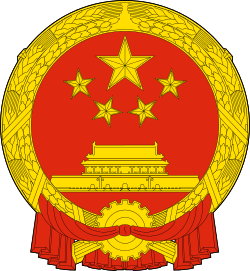
Socialist heraldry, also called communist heraldry, consists of emblems in a style typically adopted by communist states and filled with communist symbolism. Although commonly called coats of arms, most such devices are not actually coats of arms in the traditional heraldic sense. Many communist governments purposely diverged from the traditional forms of European heraldry in order to distance themselves from the monarchies that they usually replaced, with actual coats of arms being seen as symbols of the monarchs.
The Soviet Union was the first state to use socialist heraldry, beginning at its creation in 1922. The style became more widespread after World War II, when many other communist states were established. Even a few non-socialist states have adopted the style, for various reasons – usually because communists had helped them to gain independence. After the fall of the Soviet Union and the other communist states in Eastern Europe in 1989–1991, this style of heraldry was often abandoned for the old heraldic practices, with many (but not all) of the new governments reinstating the traditional heraldry that was previously cast aside.
Origin and history

The Soviet Union, created after the 1917 revolution, required insignia to represent itself in line with other sovereign states, such as emblems, flags and seals, but the Soviet leaders did not wish to continue the old heraldic practices which were associated with the feudalism the revolution sought to replace. In response to the needs and wishes, the national emblem adopted would lack the traditional heraldic elements of a shield, helm, crest and mantling, and instead be presented more plainly. This style was followed then by other socialist and communist states, which wished to also focus attention on the nation's workers and diverge from feudalism and all of its associations.
Characteristics
Socialist heraldry typically makes use of the following symbols:
- Hammer and sickle; compass
- Red and gold (yellow) five-pointed stars
- Ears or ribbons of grain or other domesticated plants,
- Interwoven ribbons in national and/or red colors, sometimes imprinted with esteemed dates, slogans and the like
- Single or multiple gears
- The rising sun
- Landscapes
- Modern industrial accessories such as electricity pylons
- Red background
- National symbols or places of national importance
- Earth
Development
USSR
The great seal of the Soviet Union was the first example of socialist heraldry. It was used in several other communist countries, particularly in Eastern Europe, Africa and Asia, except in Cuba.
Romania
The Socialist Republic of Romania created a new heraldic tradition which proved to be quite controversial. The State Heraldic committee combined stylised touristic themes, photographic representations of landscapes with old heraldic figures and modern items such as oil rigs into one whole.
Hungary
In 1974, Hungary replaced the coats of arms of 83 cities with Soviet-styled socialist emblems. Lions and eagles were replaced by cheering workers, families with toddlers and proud farmer girls reaching for the sun with their fists. All these themes were crowned by a red star.
Present
With the demise of the USSR and other Communist regimes in Europe, most of their socialist heraldry has been replaced with old pre-communist symbols or by wholly new coats of arms.
Socialist heraldry is still seen in the emblems of several countries, such as the People's Republic of China. North Korea has a national emblem in pure socialist style, as does Vietnam.
The national emblem of Belarus adopted in 1995 following a controversial referendum, is reminiscent of that of the Byelorussian SSR.
The national emblem of Macedonia is reminiscent of that of the Socialist Republic of Macedonia (once a constituent socialist republic of the Socialist Federal Republic of Yugoslavia).
In Africa, the emblems of Angola and Mozambique, as well as Algeria, use socialist heraldry.
The Republic of Serbia used the coat of arms of the Socialist Republic of Serbia[1] until the recommended symbols by the National Assembly on August 17, 2004. The recommended usage was made Law on May 11, 2009 thus officially replacing the socialist heraldic Coat of arms.[2]
Galleries
Bellow are two galleries of historical and current national emblems. The years given are for the emblems, not for the countries, except for the component republics of the USSR.
Historical emblems
Soviet Union
-

State emblem of the Soviet Union (1956-1991) -
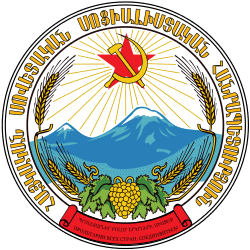
Coat of arms of the Armenian Soviet Socialist Republic (1920–1990) -

Coat of arms of the Azerbaijan Soviet Socialist Republic (1920–1990) -

Coat of arms of the Byelorussian Soviet Socialist Republic (1919–1991) -
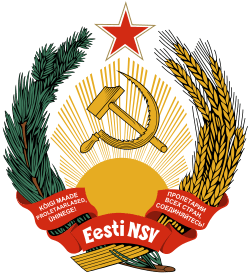
Coat of arms of the Estonian Soviet Socialist Republic (1940–1990) -

Coat of arms of the Georgian Soviet Socialist Republic (1921–1990) -
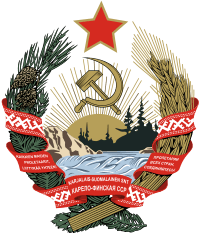
Coat of arms of the Karelo-Finnish Soviet Socialist Republic (1940–1956) -

Emblem of the Kazakh Soviet Socialist Republic (1936–1991) -

Coat of arms of the Kirghiz Soviet Socialist Republic (1936–1991) -
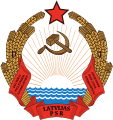
Coat of arms of the Latvian Soviet Socialist Republic (1940–1990) -

Coat of arms of the Lithuanian Soviet Socialist Republic (1940–1990) -
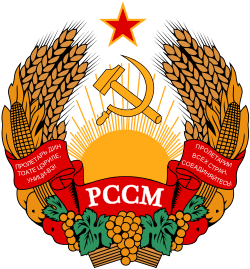
Coat of arms of the Moldavian Soviet Socialist Republic (1940–1991) -

Coat of arms of the Russian Soviet Federative Socialist Republic (1917–1991) -

Coat of arms of the Tajik Soviet Socialist Republic (1929–1991) -
.svg.png)
Coat of arms of the Transcaucasian Socialist Federative Soviet Republic (1923-1936) -
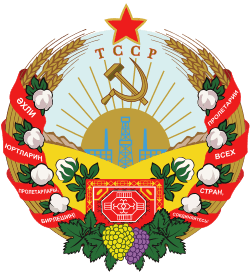
Coat of arms of the Turkmen Soviet Socialist Republic (1921–1991) -

Coat of arms of the Ukrainian Soviet Socialist Republic (1919–1991) -
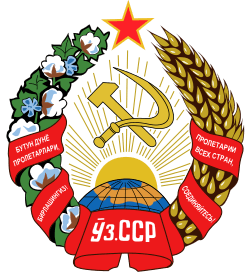
Emblem of the Uzbek Soviet Socialist Republic (1924–1991)
Africa
-
.png)
Emblem of the People's Republic of Angola (1975-1992)
-

National emblem of the People's Republic of Benin (1975-1990) -

National emblem of Burkina Faso (1984-1991) -

National emblem of the People's Republic of the Congo (1970-1992) -

Emblem of the Ethiopian Derg (1975-1987) -

National emblem of the People's Democratic Republic of Ethiopia (1987-1991) -

National emblem of the Democratic Republic of Madagascar (1975–1992) -
.svg.png) Coat of arms of the People's Republic of Mozambique (1982-1990)
Coat of arms of the People's Republic of Mozambique (1982-1990)
Asia
-
.svg.png)
National emblem of the Democratic Republic of Afghanistan (1978-1980) -
.svg.png)
National emblem of the Democratic Republic of Afghanistan (1980-1987) -

National emblem of Laos (1975-1991) -

National emblem of the Mongolian People's Republic (1960-1991) -

National emblem of Democratic Kampuchea (1975-1979) -

National emblem of the People's Republic of Kampuchea (1979-1989) -

Emblem of the Republic of South Vietnam (1969 - 1976) -
.png)
State seal of Burma (1974-2008)
Europe
-

National emblem of the Socialist People's Republic of Albania (1946-1991) -
.svg.png)
National emblem of the People's Republic of Bulgaria (1948-1968) -
.svg.png)
Coat of Arms of the Czechoslovak Socialist Republic (1961-1989) -
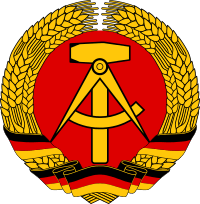
National emblem of the German Democratic Republic (1955-1990) -
.svg.png)
National emblem of the People's Republic of Hungary (1949-1956) -
.svg.png)
Coat of Arms of the People's Republic of Hungary (1957-1990) -
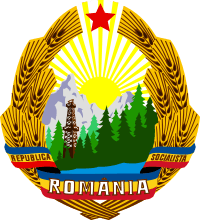
National emblem of the Socialist Republic of Romania (1965-1989) -
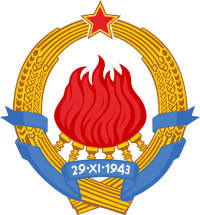
National emblem of the Socialist Federal Republic of Yugoslavia (1963–1992)
Republics of Yugoslavia
-
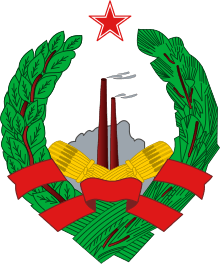
National emblem of the Socialist Republic of Bosnia and Herzegovina (1963-1992) -

Coat of Arms of the Socialist Republic of Croatia (1963-1991) -
.svg.png)
National emblem of the Socialist Republic of Macedonia (1963-1991) -

National emblem of the Socialist Republic of Montenegro (1963-1992) -
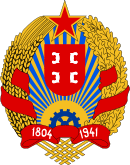
Coat of Arms of the Socialist Republic of Serbia (1963-1992) -
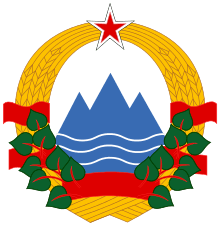
National emblem of the Socialist Republic of Slovenia (1963-1991)
Current emblems
-

National Emblem of the People's Republic of China (1950-present) -
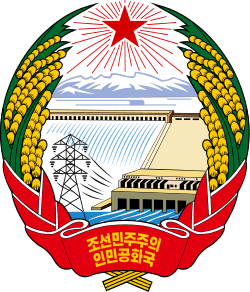
Emblem of North Korea (1948-present) -
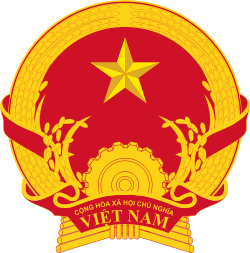
Emblem of Vietnam (1975-present, previously of North Vietnam (1955-1976)) -
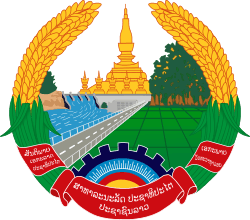
Emblem of Laos (1992-present) -
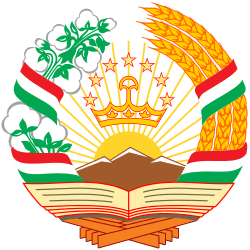
Emblem of Tajikistan (1993-present) -

Emblem of Uzbekistan (1992-present) -
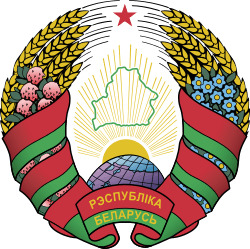
National emblem of Belarus (1995-present) -
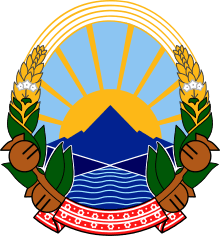
Emblem of the Republic of Macedonia (2009-present) -

Emblem of Angola (1990-present) -
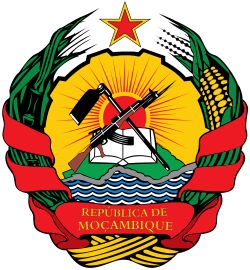
Emblem of Mozambique (1990-present)
See also
- Coat of arms of the German Democratic Republic
- Coat of arms of Laos
- Coats of arms of the Soviet Republics
- Coat of arms of the Socialist Federal Republic of Yugoslavia
- Coats of arms of the Yugoslav Socialist Republics
- Hammer and sickle
References
- ↑ Law on the use of the coat of arms of the Socialist Republic of Serbia (Serbian: Zakon o upotrebi grba Socijalisticke Republike Srbije ("SG SRS", br. 6/1985.)
- ↑ "Zakon o izgledu i upotrebi grba, zastave i himne Republike Srbije — English: Law on the Appearance and Use of the Coat of arms, the Flag and the Anthem of the Republic of Serbia". Official Gazette of the Republic of Serbia – No. 36/2009 (in Serbian). Narodna skupština Republike Srbije – JP "Službeni glasnik". 2009-05-11 (valid from 2009-05-19). Retrieved 2009-12-15. Check date values in:
|date=(help)
- Stephen Slater, "The complete book of Heraldry" London 2002